Manuka Honey Market Research, 2031
The global manuka honey market size was valued at $455.4 million in 2021, and is projected to reach $776.4 million by 2031, growing at a CAGR of 5.5% from 2022 to 2031.
Manuka honey is prepared from the nectar of the Manuka flower and is distinct from other types of honey due to its high methylglyoxal and phenolic component. The powerful antibacterial and antioxidant properties of these chemicals contribute to the health benefits of manuka honey. Owing to its antibacterial, antiviral, anti-inflammatory, and antioxidant characteristics, manuka honey has numerous health advantages. In addition, manuka honey provides customers with some unique advantages such as aiding in wound healing, preventing gastric ulcers, and improving digestive symptoms. In addition, burns heal faster when kept moist, manuka honey is advantageous for healing burns. It lowers the possibility of bandages to stick to the wound. Thus, changing a bandage is less painful and less traumatic for tissues that are regenerating. Manuka honey not only acts as a barrier to prevent reinfection, however, it also provides nutritional benefits. This dietary benefit encourages quicker wound healing. Honey provides a soothing effect, which helps most patients to feel less discomfort from burns. Manuka's capacity to reduce inflammation, which can irritate nerve endings, is one of the reason behind this. Owing to all these beneficial qualities, medical-grade manuka honey can be an effective way to mend skin grafts, thus propel the manuka honey market demand across the globe..
Furthermore, the health benefits of manuka honey are one of the drivers in the markets, which facilitate the growth of the manuka honey market. Numerous phytochemicals, including gallic acid and flavonoids galangin and pinocembrin, have been implicated in manuka honey's capacity to boost the immune system. Human monocytes or Mono Mac6 cells have been reported to produce more IL-1, IL-6, and TNF-, when exposed to manuka honey. In contrast, consumption of manuka honey is expected to cause a drop in cytokines as phytochemicals such as gallic acid reduce the formation of NF-B, interleukin-1, and TNF-, which are all side effects of inflammation. In addition, it was discovered that manuka honey had both pro- and anti-inflammatory characteristics. The anti-proliferative activity of manuka honey was investigated on murine melanoma (B16.F1), colorectal carcinoma (CT26), and human breast cancer (MCF-7) cells in vitro. The effectiveness was time- and dose-dependent, reaching a maximum of 0.6% (w/v). A caspase 9-dependent apoptotic pathway was also activated that led to the stimulation of caspase 3, which is responsible for decreased Bcl-2 expression, DNA fragmentation, and eventually apoptosis. Manuka honey is also added to a number of food and beverage products due to its many advantages, which are projected to fuel the market's expansion.
Manuka honey has been ingested and utilized in a variety of wound treatments. It has been demonstrated to have a powerful anti-inflammatory and antibacterial therapeutic properties. Neutrophils are the body's most common leukocytes and one of the primary initiators of the early immunological response to biomaterials. Manuka honey's potential as a biomaterial additive has led to encouraging findings in reducing acute inflammatory reactions from neutrophils. It also offers the benefit of methylglyoxal, which is also an anti-inflammatory and has benefits for wound healing, according to a body of studies. It includes a number of other flavonoids and phenolic elements that may have therapeutic benefits. Therapies based on manuka honey may potentially enhance host-biomaterial integration, reduce the amount of scar tissue that forms at the site of implantation, and diminish patient discomfort related to biomaterial implantation. Therefore, the possible use of manuka honey is likely to aid in the market's expansion.
The manuka trees can only be found in Australia and New Zealand. Owing to their numerous advantages, manuka trees and honey producing prospects are present all over the world. Furthermore, manuka trees are not only beneficial to human, however also to the environment as it provides shelter to wildlife creatures and protects other growing plants. Manuka bushes have benefits including reducing erosion, improving stream quality, and encouraging biodiversity. Manuka trees benefit streams in a variety of ways, such as by growing roots close to the banks to reduce erosion and by providing shade for other plants to grow. Birds, insects, and other creatures are attracted to the Manuka plants, enhancing biodiversity. Manuka seedlings are typically among the first plants to appear after a fire, which makes them a crucial part during forest regeneration. They can withstand challenging circumstances and help to create an atmosphere where other plant species can establish dominance. Therefore, rise in manuka tree output is anticipated to enhance demand for manuka honey.
The advantages of manuka honey include lowering high cholesterol or preserving a healthy balance of intestinal bacteria. In addition, certain components in manuka honey may be able to destroy specific germs and fungi. It may also give nutrients and chemicals that speed up the healing of wounds. However, when applied to the skin, manuka honey may act as a moisture barrier, preventing the skin from sticking to wound dressings. Manuka honey can pick up bacteria while being produced. Manuka honey is generally safe to use or consume, however some people may encounter unfavorable side effects such as allergic reactions or and it can increase blood sugar level, which is are not suitable for persons who have diabetes. Therefore, the adverse effects of manuka honey are expected to restrain the market's expansion.
Manuka honey has a deeper, earthier, and more viscous flavor than other types of honey. In addition, manuka honey exhibits the highest value in terms of phenolic content and antioxidant capacity when compared to the acacia, wild carrot, Portobello, and honey from Saudi Arabia, which was supplied from Germany, Algeria, Saudi Arabia, and Scotland, respectively. It has been found to have a considerable number of phenolic compounds, as well as other phenolic compounds that have been demonstrated to have a potent potential to reduce free radicals. In addition, the only native plant to New Zealand, Leptospermum scoparium, popularly known as Manuka, provides the nectar for manuka honey. The manuka plant itself is extremely rare, according to the Manuka Factor Honey Association. In addition, the bloom only lasts for 12 days thus, it is difficult to harvest it and manufacturers need to use helicopters to collect this manuka. As a result, the availability of manuka is limited and demand is high across a variety of industries, which is hampering the manuka honey market growth.
The sale of manuka honey benefited from the COVID-19 outbreak. This resulted from customers becoming more aware of their health. In addition, the COVID outbreak drastically improved the air quality owing to the reduction of transportation, industrial, and commercial activities as well as the general lockdown, which consequently, enhanced the quality of life for honeybees and products made with manuka honey.
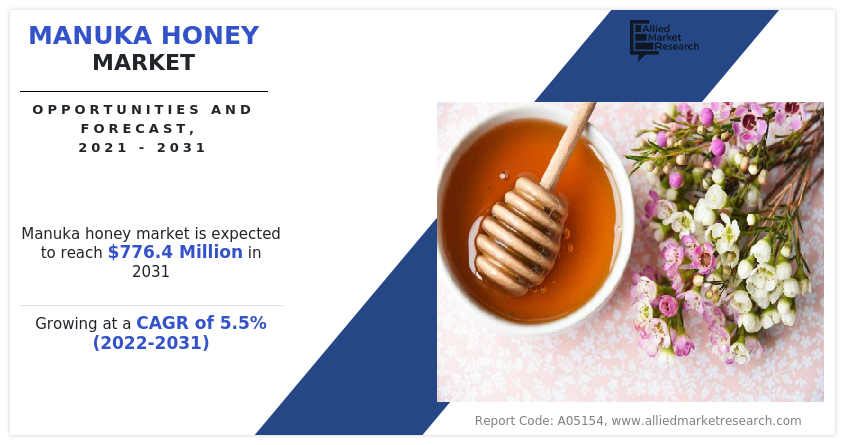
The manuka honey industry is segmented on the basis of type, nature, application, and region. On the basis of type, the market is categorized into UMF 5+, UMF 10+, UMF 15+, and UMF 20+. According to nature, the manuka honey market is fragmented into organic/natural and conventional. As per application, the market is divided into food and beverages, cosmetic and personal care, nutraceutical, pharmaceutical, and others. Moreover, the manuka honey market is further classified into third-level segmentation through the application. On the basis of food and beverages, the market is bifurcated into beverages, dairy products, bakery and confectionary and others. Region-wise, the market is analyzed across North America (the U.S., Canada, and Mexico), Europe (Germany, France, UK, Italy, Spain, Switzerland, and the rest of Europe), Asia-Pacific (China, India, Japan, South Korea, Australia, New Zealand and the rest of Asia-Pacific), and LAMEA (Brazil, South Africa, Saudi Arabia, Argentina and the rest of LAMEA).
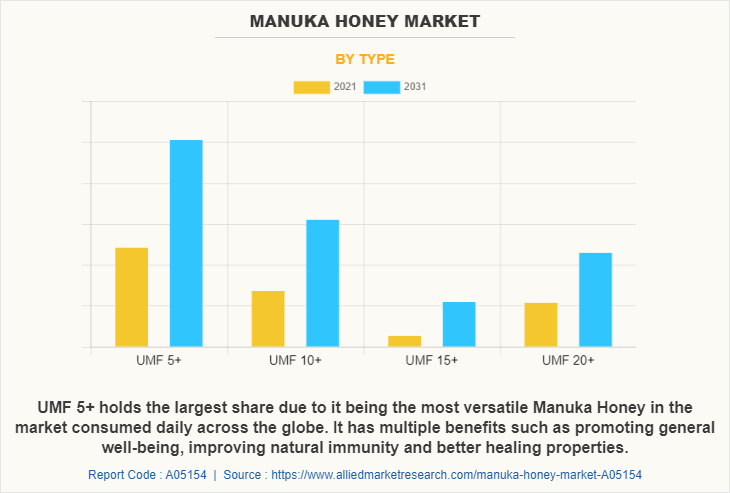
By type, UMF 5+ had the largest manuka honey market share in 2021 with a CAGR of 5.9%. In addition, it is one of the most consumed type of manuka honey on the market and is used every day all over the world. It has numerous advantages, including improving natural immunity so that you can stay protected every day and greater healing properties. According to a study, frequent manuka honey consumption may reduce the symptoms of irritable bowel syndrome (IBS). In addition, IBS and ulcerative colitis sufferers may benefit from this honey as it improves antioxidant levels and reduces inflammation (a type of IBD or irritable bowel disease).
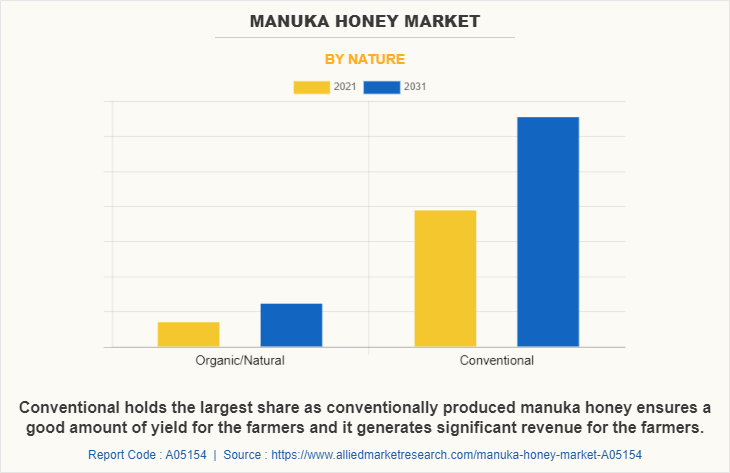
By nature, the conventional segment garners the highest revenue contribution in 2021 and is expected to reach $655.0 million by 2031 at a CAGR of 5.4%. Conventional manuka honey has a number of advantages, including protein supplies from conventional farming that give farmers comfort and convenience. It is inexpensive and widely available thanks to conventional cultivation. It is anticipated that this segment would continue to dominate in the years to come.
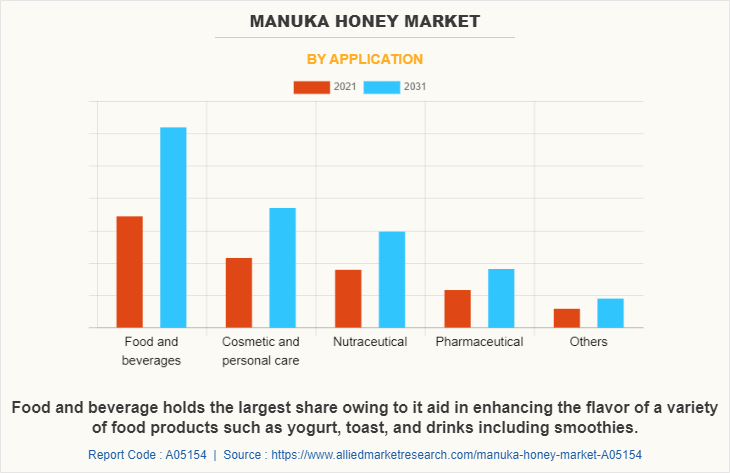
By application, food & beverages were the largest share in 2021 and are expected to have the largest market share in 2031. Manuka honey has solid, silky texture, rich, and caramel-like flavor making it one of the most popular types of honey in the market. Moreover, manuka honey is very sweet and has a flavor similar to bittersweet caramel, hence it is frequently utilized in food and beverage products.
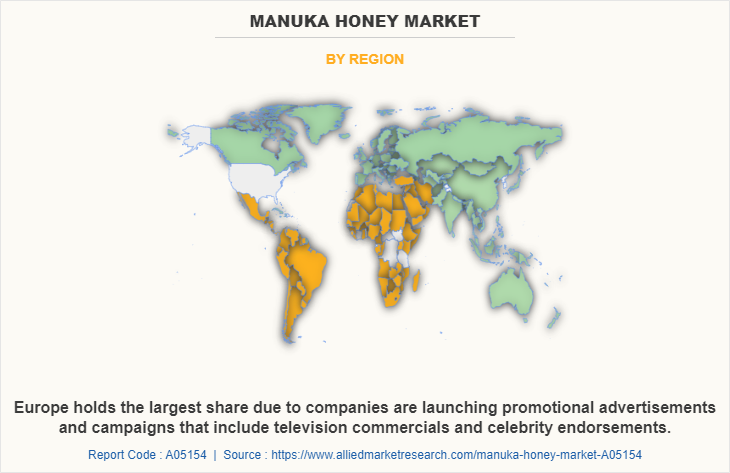
By region, Europe holds the largest share in 2021, and is expected to reach $ 296.6 million by 2031 at a CAGR of 5.2%. The dominance of European region indicates the acceptance and rising preference towards healthy products. Businesses are experimenting with fresh methods to spread the word about their products and the health advantages of manuka honey. Furthermore, the growing urban population, combined with rising disposable income and living standards, is expected to contribute to overall growth in the manuka honey market forecast period.
The market is being driven by factors such as rapid growth in the food & beverage as well as dairy industries in developing countries, as well as increased awareness of the benefits of manuka honey. The major players operating in the global manuka honey market are Comvita, Wildcape, Kiva, Manukora, New Zealand Honey Co., Airbone Honey Ltd, Three Peaks Manuka Honey, Arataki Honey, Happy Valley, Wedderspoon, Steens honey, Manuka Lab, Manuka Doctor, Egmont honey, and Manuka Pharm.
Key Benefits For Stakeholders
- This report provides a quantitative analysis of the market segments, current trends, estimations, and dynamics of the manuka honey market analysis from 2021 to 2031 to identify the prevailing manuka honey market opportunities.
- The market research is offered along with information related to key drivers, restraints, and opportunities.
- Porter's five forces analysis highlights the potency of buyers and suppliers to enable stakeholders make profit-oriented business decisions and strengthen their supplier-buyer network.
- In-depth analysis of the manuka honey market segmentation assists to determine the prevailing market opportunities.
- Major countries in each region are mapped according to their revenue contribution to the global market.
- Market player positioning facilitates benchmarking and provides a clear understanding of the present position of the market players.
- The report includes the analysis of the regional as well as global manuka honey market trends, key players, market segments, application areas, and market growth strategies.
Manuka Honey Market Report Highlights
| Aspects | Details |
| Market Size By 2031 | USD 776.4 million |
| Growth Rate | CAGR of 5.5% |
| Forecast period | 2021 - 2031 |
| Report Pages | 248 |
| By Type |
|
| By Nature |
|
| By Application |
|
| By Region |
|
| Key Market Players | Manuka Lab, Three Peaks Manuka Honey., Airbone Honey Ltd., WildCape Manuka Honey., Midlands Apiaries Ltd., Manuka Doctor, Wedderspoon Organic., Comvita Limited, Manukora Limited, Arataki Honey Ltd., New Zealand Honey Co., Steens Honey, Manuka Pharm, Happy Valley Honey, Egmont Honey |
Analyst Review
The consumption of manuka honey is on the rise owing to a surge in consumption from the commercial segment, majorly in food & beverages, cosmetic and personal care, pharmaceutical, and nutraceutical industry. Moreover, the rapid expansion of the food & beverage industry, combined with the wide range of uses for manuka honey, is helping to drive up demand for manuka honey globally. Manuka honey is in greater demand in the market owing to an increase in consumer expenditure on healthcare products.
Growing consumers’ health consciousness is influencing them to prefer natural-based products over synthetic- ones, which is expected to raise the demand for manuka honey throughout the forecast period. Manuka honey has wide applications in pharmaceuticals due to its anti-inflammatory properties., which is another growth driver for the manuka honey market.
One of the primary drivers for the increase in demand for manuka honey is the high demand for healthy products in the market. Many new market players are expected to enter the manuka honey market over the forecast period, attracted by profitable growth and high-profit margins.
Another factor that influences the demand for manuka honey is the rise in demand for organic/natural manuka honey. There is an increase in the demand for organic products as consumers are becoming health conscious. Consequently, the demand for manuka honey has seen a multifold increase in the past four years, especially in the developed countries of North America and Europe regions including however not limited to the U.S., Canada, UK, and Germany. The demand for organic manuka honey is likely to gain high traction across the world with the growing consumer awareness regarding the organic variant of the product and downward pressure on the price point.
The global manuka honey market size was valued at $455.4 million in 2021, and is projected to reach $776.4 million by 2031, registering a CAGR of 5.5%. In addition, the growth in the usage of manuka honey powder in food & beverages and pharmaceuticals industries is exponentially fostering the growth of the manuka honey market across the globe.
The major players operating in the global manuka honey market are Comvita, Wildcape, Kiva, Manukora, New Zealand Honey Co., Airbone Honey Ltd, Three Peaks Manuka Honey, Arataki Honey, Happy Valley, Wedderspoon, Steens honey, Manuka Lab, Manuka Doctor, Egmont honey and Manuka Pharm.
Demand in medical due to antibacterial properties tends to be one of the upcoming trends of Manuka honey market across the globe. Moreover, manuka honey has antifungal qualities that make it a successful treatment for fungi-related illnesses like ringworm and tinea infections.
Europe is the largest regional market for Manuka Honey Market. Moreover, it is being driven by consumers’ desire for tasty and healthy supplements. In Europe, manuka honey companies are launching promotional advertisements and campaigns that include television commercials and celebrity endorsements.
Manuka honey is one of the most popular kinds of honey among all commercially available honey in the market owing to which it is widely used in the food industry products including bakery, cereals, confectionery, dairy, ready-to-eat meals, soups, sauces, and snacks. Hence, it has a leading application in the food and beverage industry.
In the post-pandemic period, the manuka honey is expected to retain its growth. The innovations of the engaged stakeholders in the market will help create newer features in the manuka honey product, which will help gain consumer attention and will help the market growth.
UMF 5+ is projected to be the fastest-growing segment due to various factors such as it is low grade manuka honey and regularly used in a wide range of industries. In addition, it is one of the most versatile Manuka Honey in the market consumed daily across the globe.
U.S., Germany, UK, and France have an enormous market in the Manuka Honey market. This is attributed to the huge number of players in the region offering a wide range of products at lucrative prices as well as the purchasing power of the population in these countries contributing to the growth.
Loading Table Of Content...


